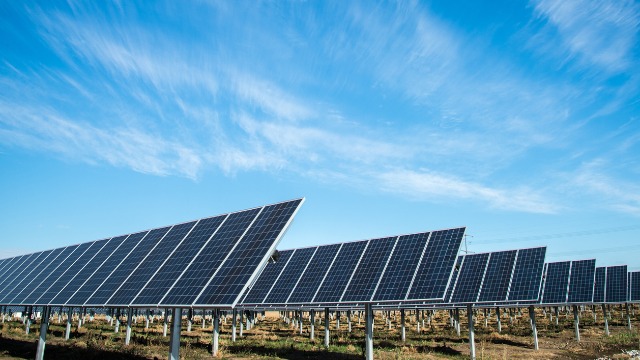Looking for new materials that make photovoltaic solar cells more efficient is a challenge that has taxed current supercomputing resources to the max.
Copyright by www.technologynetworks.com
 That’s why a number of academic institutions are collaborating with Carnegie Mellon University to tackle the task. These efforts hope to utilize Aurora, the forthcoming exascale computer at the U.S. Department of Energy’s (DOE) Argonne National Laboratory, to further their research. Argonne ESP selects projects to test run on Aurora before system launch
That’s why a number of academic institutions are collaborating with Carnegie Mellon University to tackle the task. These efforts hope to utilize Aurora, the forthcoming exascale computer at the U.S. Department of Energy’s (DOE) Argonne National Laboratory, to further their research. Argonne ESP selects projects to test run on Aurora before system launch
The Argonne Leadership Computing Facility (ALCF), a DOE Office of Science User Facility, hosts the Early Science Program (ESP) to ensure its next-generation systems are ready to hit the ground running. Fifteen ESP computational science and engineering research projects from national laboratories and universities were selected to prepare their research to run on Argonne’s Aurora exascale supercomputer, which is scheduled to launch next year.The data and learning projects support the ALCF’s efforts to create an environment that enables data science and machine learning approaches alongside traditional simulation-based research. The teams receive hands-on assistance to port and optimize their applications for the new architecture using systems available today and early Aurora hardware when it is available. Carnegie Mellon University project: researching potential materials to create more efficient solar cells
An ESP team led by Carnegie Mellon University plans to use Aurora to find materials that can increase the efficiency of solar cells. The Carnegie Mellon team uses machine learning tools extensively in their research and is working with the developers of BerkeleyGW, SISSO, and Dragonfly software to prepare to run on the Aurora system. Noa Marom (Assistant Professor, Department of Materials Science and Engineering, Carnegie Mellon University) is the Principal Investigator on the project. Co-Principal Investigators include: Jack Deslippe from Lawrence Berkeley National Laboratory (LBNL) who is the principal developer of the BerkeleyGW code; Luca Ghiringhelli (Fritz Haber Institute of the Max Planck Society and developer of the SISSO machine learning software); and Barnabás Póczos (Associate Professor, Machine Learning Department, Carnegie Mellon University).
According to Marom, “The goal of our research is to find new materials that make photovoltaic solar cells more efficient. The quest for any new materials that can enable new technologies is challenging. The materials we are researching have unique properties that make them suitable for use in solar cells, and these properties are very rare and difficult to find out of the wide array of possible materials. We are trying to accelerate the process of material discovery through computer simulation on high-performance computers (HPC) using sophisticated quantum-mechanical simulation software and machine learning (ML) tools. We are excited that our project has been accepted as one of the projects that will run on the future Aurora supercomputer as part of the Argonne ESP program. Our multi-institution team is currently modifying algorithms and workflows so they will be able to run on Aurora.” […]
Read more – www.technologynetworks.com
Thank you for reading this post, don't forget to subscribe to our AI NAVIGATOR!


Looking for new materials that make photovoltaic solar cells more efficient is a challenge that has taxed current supercomputing resources to the max.
Copyright by www.technologynetworks.com
The Argonne Leadership Computing Facility (ALCF), a DOE Office of Science User Facility, hosts the Early Science Program (ESP) to ensure its next-generation systems are ready to hit the ground running. Fifteen ESP computational science and engineering research projects from national laboratories and universities were selected to prepare their research to run on Argonne’s Aurora exascale supercomputer, which is scheduled to launch next year.The data and learning projects support the ALCF’s efforts to create an environment that enables data science and machine learning approaches alongside traditional simulation-based research. The teams receive hands-on assistance to port and optimize their applications for the new architecture using systems available today and early Aurora hardware when it is available. Carnegie Mellon University project: researching potential materials to create more efficient solar cells
An ESP team led by Carnegie Mellon University plans to use Aurora to find materials that can increase the efficiency of solar cells. The Carnegie Mellon team uses machine learning tools extensively in their research and is working with the developers of BerkeleyGW, SISSO, and Dragonfly software to prepare to run on the Aurora system. Noa Marom (Assistant Professor, Department of Materials Science and Engineering, Carnegie Mellon University) is the Principal Investigator on the project. Co-Principal Investigators include: Jack Deslippe from Lawrence Berkeley National Laboratory (LBNL) who is the principal developer of the BerkeleyGW code; Luca Ghiringhelli (Fritz Haber Institute of the Max Planck Society and developer of the SISSO machine learning software); and Barnabás Póczos (Associate Professor, Machine Learning Department, Carnegie Mellon University).
According to Marom, “The goal of our research is to find new materials that make photovoltaic solar cells more efficient. The quest for any new materials that can enable new technologies is challenging. The materials we are researching have unique properties that make them suitable for use in solar cells, and these properties are very rare and difficult to find out of the wide array of possible materials. We are trying to accelerate the process of material discovery through computer simulation on high-performance computers (HPC) using sophisticated quantum-mechanical simulation software and machine learning (ML) tools. We are excited that our project has been accepted as one of the projects that will run on the future Aurora supercomputer as part of the Argonne ESP program. Our multi-institution team is currently modifying algorithms and workflows so they will be able to run on Aurora.” […]
Read more – www.technologynetworks.com
Thank you for reading this post, don't forget to subscribe to our AI NAVIGATOR!
Share this: